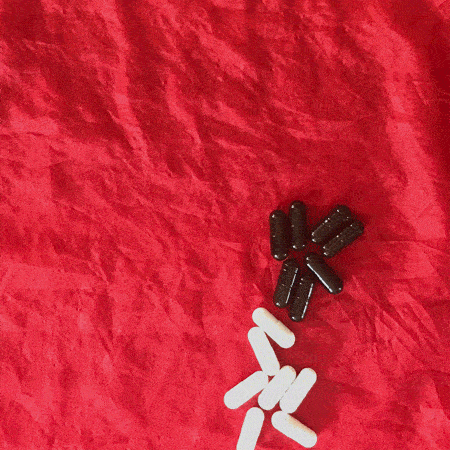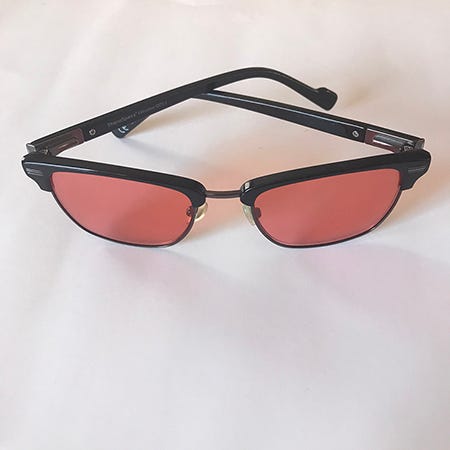Every seventh piece for Year 5 is a guest piece, and this fourth one is by another friend and longtime collaborator Rachel Cassandra. Rachel is a nonfiction storyteller who works in audio and print. I first met her in 2010 when she started coming to our art collective meetings, which helped us to see ourselves as an Art Collective. She took us seriously, so we took ourselves more seriously. While Rachel and I have become personally very close since then, we each still hold a large amount of respect for the other artistically. We give each other permission to be our best artist selves, or even unspokenly dare each other to be. Though of course simultaneously holding space for each other to be exactly where we are at.
Rachel was the very first person I gave a Rainbow Squared oracle reading to, drawing a three-card spread for her almost a year ago. Just like with the art collective, sharing this practice with Rachel helped me to see it as serious.
7. Red Black White
Red: body, life, survival, blood, cycles, physicality, livelihood
Black/White: transcendence, interconnectedness, light, polarity, culmination
I’m nineteen, with my best friend H in Montreal, where we’ve just taken our first road trip up north from New Jersey where we went to school together. We wander in the day, and night comes and we meet a band of retro bicyclists. Guys our age, maybe a little older. I still have a photo of them, all black and white and chrome on pavement. We were tipsy on champagne we had swigged from the bottle. They offered us dry, shriveled mushrooms, which we accepted and chewed, the psychedelics coming up as the people drained from the streets and the real night began.
My clearest memory is of me and H in the bathroom of the apartment of one of the bicyclists. It was all black and white tile and fixtures with big mirrors. The apartment was grubby and unremarkable, but the bathroom on mushrooms was this infinite, cold palace: black and white extending forever. H called me in because she got her period. She was sitting on the toilet, showing me what she’d found. In my state, the blood seemed to smear all over us and the bathroom, a crimson blight in that colorless space. In our high-ness, the situation felt incomprehensibly complicated, but I tried to scavenge something to help. The boys had no toilet paper or paper towels. I can’t remember what we ultimately did, maybe found a scrap of fabric or washcloth. It was inexplicable to us that they would have nothing in the house to sop up the blood our bodies leaked every month.
As it turned to morning, one of the guys tried to seduce H by rolling some kind of beaded bracelet on her skin, so we left. It was always happening like that for us back then, the boys ruining the vibe by trying to get sex. They didn’t understand.
Red, black/white. The blood in the black and white bathroom. The blood that breaks the barrier between childhood and adulthood, that prepares the body for sex and motherhood. The blood of first penetration, of rape. The white of childhood underwear. The way women often switch to only wearing black underwear after we start menstruating, because you never know exactly when you’ll bleed. Red is the sex that was always underneath our world, but which we couldn’t see until we became adults ourselves. Red was the sex that began to muddy the waters of pure friendship.
H was my confidant in this whole murky transition into adulthood. We were the ones saving each other when one of us was too high to be around some clumsy, fumbling guy. But soon enough, I would question my feelings about H, my emotions culminating in a panic attack in a sushi restaurant parking lot. How I may be in love with her, how sex could ruin a friendship, how queerness could mar my life. How that kind of love for her could be a betrayal. The red that perforates the conventions of love and relationships, that blurs the lines of friends and lovers, the red that queers my childhood world. The violence of tearing down the black and white world as you knew it, as you were taught.
Then, in another betrayal, I sleep with H’s brother. A sin in her book and, as I would wonder later, perhaps a much simpler way of burning down the complex architecture of our friendship. I trade the indelible shame of queer feelings for the simpler ones of sex behind someone’s back. This is the second time I am manic, the first time I ruin my life because of it, the first time I lose a love (H), and the only time that my life collapses for months in heartbreak. This is the white/black of mania and depression, set on the backdrop of the red of sex, the rose red of the carnal romance novel, the red of loves kept secret.
Black/white is the polarity of my mind, a feature of my life it took me eight more years to grasp. It was the black, white, black that characterized my moods beginning when I came of age, cycling through, damaging friendships, cultivating art, and ultimately landing me in a relationship so intimate and stable, it forced me to figure it all out.
Black/white—the overly simplistic representation of emotional extremes. In between those lay all the shadows and highlights, a value scale I impose on life now that I can’t un-see. This new voice tells me, ‘that’s mania’, starting to peek out through my sleepless nights. ‘That’s depression,’ whispering thoughts of death and disconnection. We-who-are-chosen-for-this-kind-of-life experience the widest range of human emotion, the most detailed spectrum between those poles of black and white. Black, white, black, white, black, white. It’s the relief of knowing the blackness will pass and the sickening feeling that even when it has passed, it will return again someday.
Black/white is also the transcendence of these emotions, which, in a counterintuitive twist, I have only found through red—the body, the physicality. Running is my main tool. I run and my body transcends anxiety and depression. I run and the dark curtains part to let in bits of light. And when my mind is hot white—the joy and franticness threatening to harm my relationships and stability—yoga, stretching, walking, dim the brights and still my mind. Grounding myself in my body allows me to see the moods for what they are—transient and distinct from the me-ness below them.
The body is my escape, but also my burden. This year, I had a dramatic, debilitating reaction to the vaccine. Migraines. At first, weeks in bed, shutting out the light completely, the volume on my headphones as low as it could go. I listened to a mix my boyfriend made me on repeat while I rested under my blankets in blackness. The black, the dark, the only safe space from the sunlight piercing my eyes.
The red, the body, the pain was inescapable. Black/white is interconnectedness, interdependence, the way my sick body made me rely on others. My housemate making me food, my boyfriend researching migraines and doing my taxes. Then, when I could emerge from my bed into the months of milder migraines that were to follow, my doctor researching alternative treatments, my bosses adapting my bartending work to avoid sun.
The pain forced me to withdraw from all screens—computers, phones—to rebuild my life offline, grounded only in the real, material world. Me, separated from the online world built of binary 0s and 1s, black/white code. The vulnerable body a reminder that none of us are truly separate individuals, regardless of what Western culture teaches.
Red/black/white are the colors of my migraine glasses—special red lenses that filter out certain light and keep my eyes from feeling like they’re being rubbed with fine-grained sandpaper all day. I wore these glasses every day for months, only now taking them off for my better days.
Black/white are the supplements I take to heal—quite literally a black pill and a white pill, CoQ10 and Magnesium.
And the tattoo I etched on my skin to remind myself that there is no beauty without darkness, that I am not capable of feeling the pleasure of existence without its counterpart? A black and white rendering of the red opium poppy. The poppy itself is red/black/white; its bright red blossoms are a background for its black-and-white center. That poppy is excruciatingly beautiful, but it’s pods have a deep history of war, addiction, slavery.
If I had to pick a color to represent all colors, it would be red. It’s the first color we see as infants, before our vision fully develops. The archetypal color intersecting with the archetypal shades, black and white. These are not the colors of our soft forests or of our oceans, of our hands or faces. They’re of blood, warning, sex, death, chaos, madness. Red, black/white. Red the first color and black/white the last color in this project’s spectrum, offering closure and completion, or perhaps just a transition to the next cycle. We bleed, we celebrate and mourn, we fall sick and get well, and know that just as surely as something passes, it will come again.





